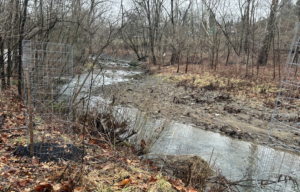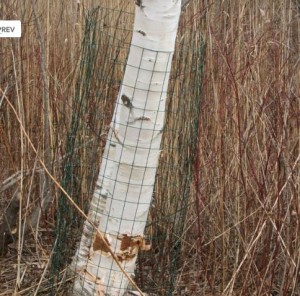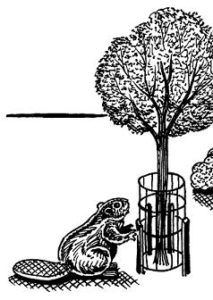
Category: Beaver Chewing
There’s a dearth of direct beaver news but there is a bit of scientific news that sounds very beaverish:
![]()
New wood-based technology removes 80% of dye pollutants in wastewater
by Chalmers University of Technology

Researchers at Chalmers University of Technology, Sweden, have developed a new method that can easily purify contaminated water using a cellulose-based material. This discovery could have implications for countries with poor water treatment technologies and combat the widespread problem of toxic dye discharge from the textile industry.
Clean water is a prerequisite for our health and living environment, but far from a given for everyone. According to the World Health Organization, WHO, there are currently over two billion people living with limited or no access to clean water.
This global challenge is at the center of a research group at Chalmers University of Technology, which has developed a method to easily remove pollutants from water. The group, led by Gunnar Westman, Associate Professor of Organic Chemistry focuses on new uses for cellulose and wood-based products and is part of the Wallenberg Wood Science Center.
The researchers have built up solid knowledge about cellulose nanocrystals—and this is where the key to water purification lies. These tiny nanoparticles have an outstanding adsorption capacity, which the researchers have now found a way to utilize.
“We have taken a unique holistic approach to these cellulose nanocrystals, examining their properties and potential applications. We have now created a biobased material, a form of cellulose powder with excellent purification properties that we can adapt and modify depending on the types of pollutants to be removed,” says Gunnar Westman.
Absorbs and breaks down toxins
In a study recently published in the scientific journal Industrial & Engineering Chemistry Research, the researchers show how toxic dyes can be filtered out of wastewater using the method and material developed by the group. The research was conducted in collaboration with the Malaviya National Institute of Technology Jaipur in India, where dye pollutants in textile industry wastewater are a widespread problem.
The treatment requires neither pressure nor heat and uses sunlight to catalyze the process. Gunnar Westman likens the method to pouring raspberry juice into a glass with grains of rice, which soak up the juice to make the water transparent again.
“Imagine a simple purification system, like a portable box connected to the sewage pipe. As the contaminated water passes through the cellulose powder filter, the pollutants are absorbed and the sunlight entering the treatment system causes them to break down quickly and efficiently. It is a cost-effective and simple system to set up and use, and we see that it could be of great benefit in countries that currently have poor or non-existent water treatment,” he says.
![]() Wood in water. That sounds dam familiar!
Wood in water. That sounds dam familiar!
“Going from discharging completely untreated water to removing 80% of the pollutants is a huge improvement, and means significantly less destruction of nature and harm to humans. In addition, by optimizing the pH and treatment time, we see an opportunity to further improve the process so that we can produce both irrigation and drinking water. It would be fantastic if we can help these industries to get a water treatment system that works, so that people in the surrounding area can use the water without risking their health,” he says.
Can be used against other types of pollutants
Gunnar Westman also sees great opportunities to use cellulose nanocrystals for the treatment of other water pollutants than dyes. In a previous study, the research group has shown that pollutants of toxic hexavalent chromium, which is common in wastewater from mining, leather and metal industries, could be successfully removed with a similar type of cellulose-based material. The group is also exploring how the research area can contribute to the purification of antibiotic residues.
But let me tell you a little secret:
This is what beaver poop looks like… a mini sawdust snowball. This beaver poop is special though because this beaver poop is out of the water. Beavers almost always poop in the water, usually within the very ponds where they spend most of their time.

![]()
It may not be nanocrystal cellulose but it’s twice chewed and filters water real well!
We’ve been cleaning water for a long time but in Iowa some of us figured that we better start farming willow before there was nothing left to eat except corn!
 Walking sticks? Forgoing a bit of bark today for a whole willow in a few years is just the sensible thing to do when humans keep whacking down your favorite food! Watch the whole video though. It’s good!
Walking sticks? Forgoing a bit of bark today for a whole willow in a few years is just the sensible thing to do when humans keep whacking down your favorite food! Watch the whole video though. It’s good!
In the 15-year history of this website I have written very few stories of Pennsylvania. Maybe a couple here and there,with beavers being trapped for chewing trees or causing flooding but this is the first WELCOME BEAVER! article I’ve read that I can recall. It’s not brimming with accurate information but we are soo darn happy it’s there at all I won’t complain. Say hello to Frick park.
What Frick Park’s resident beaver means for the health of the restored Nine Mile Run
 Frick Park’s newest resident is causing quite a stir. Wildlife fans and hikers have come to the park in the weeks since park rangers first spotted a beaver in late December, with hopes of stealing a glance.
Frick Park’s newest resident is causing quite a stir. Wildlife fans and hikers have come to the park in the weeks since park rangers first spotted a beaver in late December, with hopes of stealing a glance.
But like many others who came before, resident Jane Bernstein returned to the parking lot just off the Nine Mile Run trail unsuccessful. Since the flat-tailed mammal is nocturnal, Bernstein got to the park before 8 a.m. on a snowy Friday this January.
This wasn’t the first time she had gone to look for him, either.
“I went on a beaver walk with somebody from Nine Mile Run — a group — and that was great,” Bernstein said. “We learned a lot about how excited they are about the beaver, despite the fact that the beavers do gnaw down trees.”
Excited about the beaver! Imagine! Frick park is in an oasis of wooded steep trails in the middle of the city of Pittsburgh. It was a large estate bequeathed for a park in the early 1900’s by Henry Clay Frick an early founder of the Coke industry which was a treatment for coal that fueled iron smelting.
So I guess it’s kind of nice a fossil fuel’s founders tax write-off is happy to see beavers?
 While elusive, the beaver, aptly nicknamed Castor — the North American beaver’s scientific name is Castor canadensis — leaves a pretty clear trail of pointed, jagged little sticks behind him.
While elusive, the beaver, aptly nicknamed Castor — the North American beaver’s scientific name is Castor canadensis — leaves a pretty clear trail of pointed, jagged little sticks behind him.
“You can see he’s been out munching around,” park ranger Erica Heide points out as she walks down a path parallel to the stream.
Castor is the second beaver to be spotted in the park in recent years, according to Heide. The first one appeared in Nine Mile Run in 2019, likely having migrated up from the Monongahela River, the waterway that sits at the mouth of the stream.
Heide said that the beaver stayed in the area for about a year, but no mates or kits (the term for baby beavers) were spotted with him.
“He moved on, we assume, for mating season,” Heide said.
So far, Castor has appeared alone at Nine Mile Run, too. Heide said while beavers are friendly within their family units, they’re territorial creatures, with just one family inhabiting a single section of a waterway at a time.
In any number, though, Heide said the presence of beavers is a sign of a healthy ecosystem where sewage and industrial waste once dominated.
“They are known as nature’s engineers,” she said enthusiastically. “They’re the only one of the only species that can change their environment and alter the hydrology.”
I would say the hardy beaver is a BRINGER of a healthy ecosystem – not exactly a sign of one. I mean there are beavers in Chernobyl and I’m pretty sure that’s not healthy. But still I get your point. They can do good things for the hydrology.
 This years-long effort to detoxify the stream, led by the City of Pittsburgh and the U.S. Army Corps of Engineers, included rerouting the stream channel by adding curves and ripple rocks to slow down the water and the rate of flooding.
This years-long effort to detoxify the stream, led by the City of Pittsburgh and the U.S. Army Corps of Engineers, included rerouting the stream channel by adding curves and ripple rocks to slow down the water and the rate of flooding.
A decade and a half later, fish and beavers have continued the work of improving the surrounding wetland environment. For instance, beavers’ chomping habits can be useful in shaping a climate-resilient landscape.
“See how clustered and how tight they are,” Heide said pointing to a group of streamside willow branches. “That’s actually really bad. They’re even starting to uproot themselves because of how heavy they are.”
But beavers love to eat willows, which grow back once cut down.
“It will cut those down and then they can regenerate into like a healthier cluster,” she explained.
Doing so helps protect the stream bank from erosion. Heide said the parks plan to plant more willows this spring and will hold several willow staking events where residents can get involved.
To protect the trees they want Castor to stay away from, park rangers and conservation groups put protective cages around nearby trunks, prioritizing those that are young and native to the northeast, like oaks, aspens and maples.
Well I would rather have a team of beavers working on that stream than the army core of engineers, but honestly, I’m not sure about your statement that FISH helped the stream, That’s like saying cars help roads?
Heide said it’s unlikely beavers will ever build a successful dam on Nine Mile Run. During storm surges, the area is susceptible to intense flooding that dams would likely not withstand.
Still, if Castor or any other beaver in the park was able to complete a dam, Heide said it would be another step toward successful environmental restoration. For one thing, it can cause flooding that brings up nutrients and seeds from the water into the soil, sparking a surge in vegetation for wildlife to eat.
At the same time, dams can further reduce the rate of flooding by slowing down floodwaters while filtering out pollutants that travel downstream.
Well that’s no more than the truth. I think I like having a beaver welcoming committee strew their path with good news. And hey the name can’t hurt. “Heide” (Hmm even if she spells it wrong…)
Hiller said the organization hopes to continue that work to protect the health of habitats throughout the watershed and restore other parts of the park, like the Fern Hollow Valley.
The presence of a beaver, he added, is a sign that they are headed in the right direction. For those who want to see the beaver, Heide advises people not to get their hopes up.
“He’ll probably become more and more elusive as we get into the colder and colder weather,” she said. “Just like us, we don’t want to be out in the cold. Neither does he.”
In the event he is spotted, Heide stresses that people give him space, and keep any dogs in the park on leash.
“That will ensure that this beaver is safe for future years to hopefully come back.”
Gosh. I’m still waiting for the other shoe to drop. But I guess it’s darn cool that a industry giant’s park can be somewhere that is happy to have beavers. I’m pretty sure that wasn’t always the case.
Isn’t that sweet! Beavers in Clearfield Pennsylvania get a housing makeover! Of course the temperature this morning is 25 so they’ll probably die alone separated from their food cache and family members but still, isn’t that sweet?
Bye bye beavers: Clearfield’s beavers to be re-homed
Beavers destroying expensive trees in downtown Clearfield are getting a new home, Street Commissioner Todd Kling reported at Thursday night’s committee meetings of the Clearfield Borough Council.
Beavers have moved into downtown Clearfield and are reportedly living in the West Branch of the Susquehanna River near the Market Street Bridge.
The beavers have removed several recently planted saplings and significantly damaged several fully grown trees on both sides of the riverbank near the bridge. The recently planted saplings cost roughly $150 a piece.
That’s right. The trees cost us MONEY. And we couldn’t possibly spend more money affording wire to wrap them in to protect our investment from these beavers or the NEXT beavers that come along. Instead we had to pay a trapper to pretend to move them. We hired “Wildlife Deceivers: We pretend so you don’t have to” just for this.
At first the beavers were destroying the trees near the Joseph and Elizabeth Shaw Public Library, so the borough put up fencing to protect the remaining trees. The beavers then started cutting trees on the west side of the river.
We tried doing the right thing, but it was hard and we decided to give up and do the other thing instead which was a lot easier.
Kling said the state Game Commission has stepped in and begun trapping the beavers alive and relocating them to a safe location. The beavers won’t be harmed.
He said the Game Commission has already caught one beaver, but it is believed there are more beavers left. Kling said now that they have professionals involved, he hopes private citizens don’t try to trap the beavers.
Borough Operations Manager Leslie Stott said residents have reported seeing three beavers.
We only saw three that one time so we know that’s how many there are every other time. I’m sure we won’t leave any orphans alone to die. As long as those pesky citizens don’t but in and start messing things up. They always get in the way.
Kling said the borough is planning to remove the dead trees and replant new trees using grant funds next year.
That’s my favorite part. Obviously next year there won’t be any more beavers because they only come ever other year or during el nino or whatever magical reason you want to make up. We have decided as a county it’s too hard to fix the problem, so we’re just going to move it.

TREE WRAP RAP
When the beaver starts a’chewing There’s a thing you should be doing If you want to save your treeline Better go and make a beeline For the wire Get a plier It’s not dire I’m no liar Do the tree-wrap, rap Do the tree-wrap, rap In the yard and in the garden Wrap it up and beg their pardon Not too tight, the tree will widen And it the wire it will tighten Wire thicken Not for chicken Paint with sandy Comes in handy Do the tree-wrap, rap Do the tree-wrap, rap Save your maple and your aspen Here’s the point that needed graspen’ Come protect the plants that need you And the fruit trees that will feed you I’m not crazy Don’t be lazy Stop your trappin’ And start wrappin Do the tree-wrap, rap Do the tree-wrap, rap! It was March 21 2015 when I wrote these lyrics. Whew, People have gotten sooo much smarter since then. HA!What I really want to read about is some smart community that has decided to deal with beavers in a pro-active way, rather than in a predictably trappy way. Don’t you want to hear a story like that?
Busy beaver chews down 5 trees near Newmarket youth centre (12 photos)
 The town is grappling with a beaver damaging several trees near its youth centre but said it will focus on mitigation rather than relocating the creature.
The town is grappling with a beaver damaging several trees near its youth centre but said it will focus on mitigation rather than relocating the creature.
A beaver has been set up at the Holland River for several weeks, bringing trees down in its dam-building efforts. But the animal has kept busy, and has now taken down five trees, some planted by the town. It has also started working on the other side of the river by the town seniors’ centre.
But regardless, the town approach will not be to directly intervene. The public works department said it is aware of the beaver but will try alternative methods instead. (more…)







































